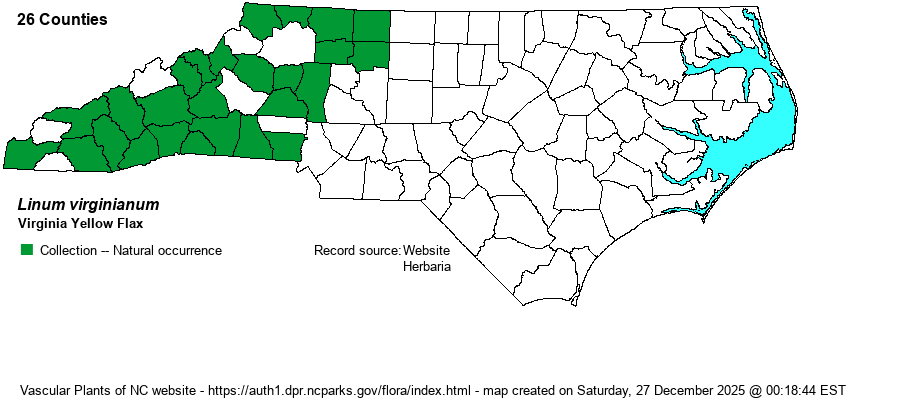| Author | L. | |
| Distribution | Present only in the Mountains and western Piedmont, ranging east to Stokes, Forsyth, Iredell, and Cleveland counties.
This species ranges from MA and MI south to SC, AL, and MO. | |
| Abundance | Fairly common to common in the Mountains; infrequent to fairly common in the western Piedmont. | |
| Habitat | This is an upland species of dry to mesic, mostly open settings. It grows in fields, wooded margins, roadbanks, open woods, and similar places. | |
| Phenology | Blooms and fruits from June to October. | |
| Identification | The Linum species are quite difficult to identify, especially as many of the former varieties and subspecies have now been elevated to full species. All are erect herbs to 1-2 feet tall, with slender branches that are usually ascending, small and narrow leaves, and numerous scattered small yellow flowers (with 5 petals) along the upper portions of the branches. This species has a globose fruit, with a depressed apex -- as do L. curtissii and L. striatum. The latter has angled stems and branches, as opposed to rounded in the other two, and L. striatum also has a paniculate inflorescence and not corymbose as in the other two. L. virginianum is separated from L. curtissii mostly by range, as the latter species is found in the Coastal Plain and eastern half of the Piedmont. That species also has the "Margins of the inner sepals with conspicuous stalked glands; mature fruits of dried specimens usually adhering to the plant", as opposed to "Margins of the inner sepals glandless, or with a few inconspicuous, sessile glands; mature fruits of dried specimens usually shattering and falling freely" (Weakley 2018). | |
| Taxonomic Comments | Though L. virginianum has always been a named species, older references typically included one or more current species within it. As a result, many specimens labelled as "Linum virginianum" might not now be correct to the species as named in Weakley (2018).
Website editors have received much help in species boundaries and in identification from Rogers (1963, 1984). | |
| Other Common Name(s) | Virginia Flax, Woodland Flax, Woodland Yellow Flax | |
| State Rank | S3? [S4] | |
| Global Rank | G4G5 | |
| State Status | | |
| US Status | | |
| USACE-agcp | FAC link |
| USACE-emp | FACU link |

